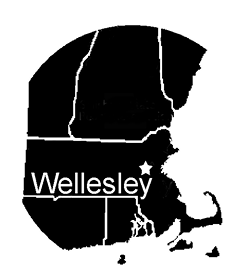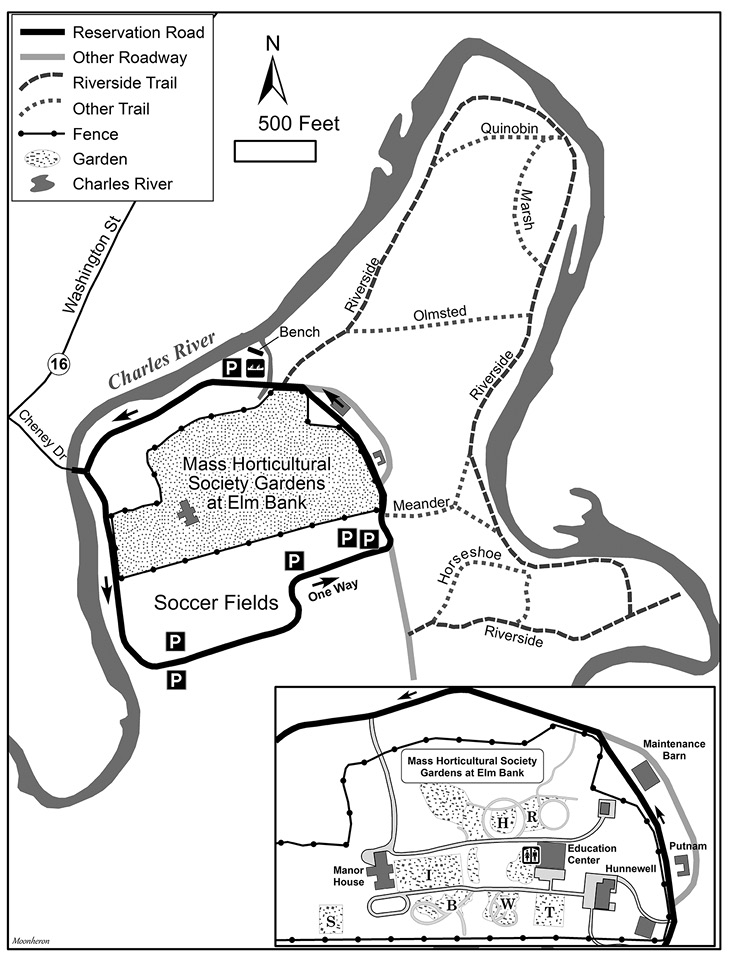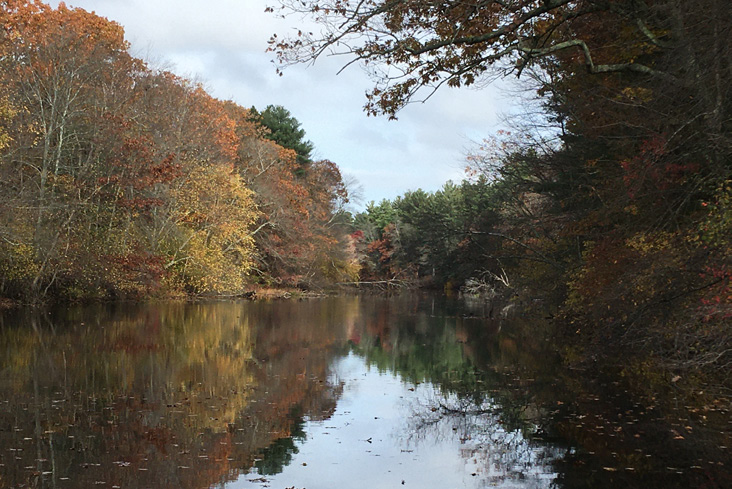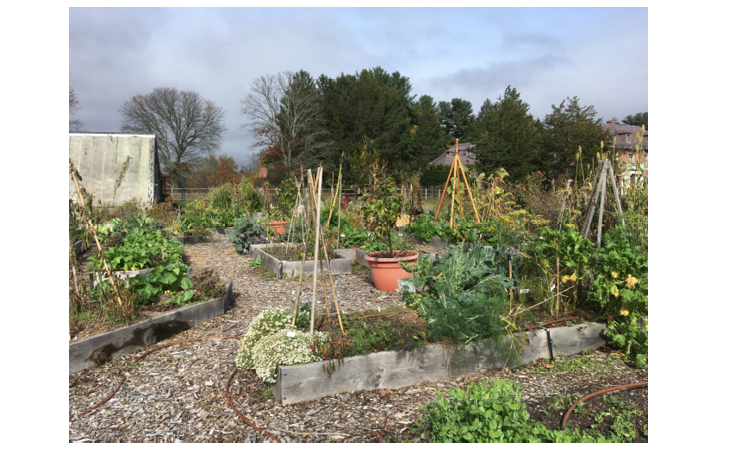Marsha C. Salett
 When the prospect of braving bone-chilling winds along the coast is less than appealing and local ponds may be frozen, birding at Elm Bank Reservation is a fine way to spend half a winter's day outdoors. If there is little or no snow on the ground, the trails through the woods along the Charles River offer birding sheltered from the wind. Alternatively, if the trails are icy, you can bird along the paved main road and on the accessible paved or crushed gravel garden paths of the Massachusetts Horticultural Society's (Mass Hort) Gardens at Elm Bank. Or you can bird a combination of natural habitats and landscaped grounds.
When the prospect of braving bone-chilling winds along the coast is less than appealing and local ponds may be frozen, birding at Elm Bank Reservation is a fine way to spend half a winter's day outdoors. If there is little or no snow on the ground, the trails through the woods along the Charles River offer birding sheltered from the wind. Alternatively, if the trails are icy, you can bird along the paved main road and on the accessible paved or crushed gravel garden paths of the Massachusetts Horticultural Society's (Mass Hort) Gardens at Elm Bank. Or you can bird a combination of natural habitats and landscaped grounds.
Elm Bank Reservation is a 182-acre recreational area that is owned by the Commonwealth of Massachusetts and is under the auspices of the Department of Conservation and Recreation (DCR). In 1996 the Commonwealth gave Mass Hort a 99-year lease of 36 acres for its Gardens at Elm Bank. (Read about the individual gardens at https://masshort.org/the-gardens-at-elm-bank/.) The access is in Wellesley, but most of the property is located in Dover. In addition, the Town of Natick has four soccer fields at Elm Bank. Mass Hort has fenced off the area that contains its gardens and buildings, and charges admission—$10 per person for nonmembers; free for children 12 and under—from the beginning of May through Columbus Day, when the gardens are open from 10 am to 4 pm, Tuesday through Sunday. The gardens are then closed to the public until the Festival of Trees in December. In winter, if the gates are unlocked, you can wander through the gardens. The Education Building is open weekdays year-round. Mass Hort announced its new president in October 2019 and also its new master plan, so changes may be forthcoming. Check the website masshort.org or call 617-933-4900 for current information about the Gardens. You can explore the rest of Elm Bank Reservation and all of the nature trails for free all year long.

Map of Elm Bank Reservation
Mass Hort made the decision to put up an iron fence around The Gardens at Elm Bank in order to have a dog-free area to protect the beautiful cultivated gardens. Elm Bank is a favorite spot for dog walkers and, unfortunately, leash laws are not enforced. Dog owners are notorious for not picking up after their pets here, but I have noticed some improvement over the past two or three years. The best time of day to bird Elm Bank is early morning or mid to late afternoon to avoid most of the dogs. Late afternoon in winter can also be good for hearing owls.
Historically, the area had been farmed since the 17th century and was known as the Natick Plain. In 1740, Colonel John Jones bought the property, which is bordered on three sides by the Charles River, and planted elm trees along the riverbanks. The elms are long gone, but the name "Elm Bank" remains. In 1874, Benjamin Pierce Cheney—a founder of the company that became American Express—bought the property. He became a member and benefactor of the Massachusetts Horticultural Society. His daughter Alice and her husband Dr. William Hewson Baltzell built the impressive 45-room Neo-Georgian manor house that still stands at Elm Bank today (unoccupied and in a state of disrepair) and commissioned Frederick Law Olmsted's sons to design the gardens, including the Italianate-style garden, which has been restored. With no heirs wanting the property, Elm Bank eventually was purchased by the Commonwealth of Massachusetts in the 1970s. And now the Cheney-Mass Hort connection continues. The entire property was placed on the National Register of Historic Places in 1987.
The official address for Elm Bank and Mass Hort is 900 Washington Street, Wellesley. The entrance road, Cheney Drive, is directly off Route 16 (Washington Street) in Wellesley and is marked with a small green sign for Elm Bank that is easy to miss. If you are on Route 16 heading west and reach South Natick Center, or are going east and come to Wellesley College, you have passed it, and you will need to turn around. Drive over the historic, one-lane Cheney Bridge, and turn right on the main reservation road, which is one way. (See Figure 1. Elm Bank Reservation.) In approximately 0.5 mile, turn left at the stop sign. You will see parking lots on your left, but continue around the road past the buildings, greenhouses, Putnam building, and maintenance barn. At the stop sign, turn left, drive across a short stone-walled bridge, and park at the Canoe Launch parking lot. If this small lot is not plowed, drive around the loop again, park in the main lot, and walk down the road to the Canoe Launch.
Elm Bank Nature Trails
Walk across the grass or snow to the edge of the Charles River and look downstream for winter ducks: Mallards, Hooded and Common mergansers, and occasionally in late March, Wood Ducks. Sit for a few minutes on the bench and watch to see what swims by; patience can be rewarding. Look overhead for Red-tailed and Cooper's hawks. Listen for Mourning Doves, Blue Jays, Carolina Wrens, House Finches, American Goldfinches, and Northern Cardinals. If you are here late in the afternoon, listen and look for Eastern Screech Owls in the oak trees along the riverbank. One early afternoon in January while I was watching Mallards, I heard a Great Horned Owl hoot a single Who's awake, me too from nearby pine trees on the Riverside trail. I immediately rushed into the woods searching for the bird, but could not find it roosting in the dense conifers. Nor did it call again.
Before you head to the road, walk along the shrubs and trees at the edge of the river, where you may startle up a Winter Wren. American Robins frequent this tangled thicket, especially if there are still berries.
When you get to the road, turn left and walk onto the narrow stone bridge (watch out for oncoming cars). The sunnier wall on the left is a good spot for Golden-Crowned Kinglets. This is the only place that I have looked down at kinglets foraging in the shrubs and picking up seeds that have collected in the cracks of the wall. When you get to the woodland trails, you will have plenty of opportunity to crane your neck up to watch them fluttering near the tops of the pines. The other side of the bridge is usually a birdy spot for Black-capped Chickadees, Tufted Titmice, White-breasted Nuthatches, Song Sparrows, and Dark-eyed Juncos.

Charles River by the canoe launch. All photographs by the author.
Now you have two choices: bird the main road around Elm Bank or the DCR woodland nature trails. Depth of the snow might make this a moot point. When the temperature is well below 32 and the ground is snow-covered, these trails in the woods are among the iciest trails anywhere—and the last to melt because the low winter sun barely penetrates the conifers. I highly recommend ice-grippers.
Right after you cross the bridge, you will come to the trailhead on the left side of the road. There is a faded map of the trail system. Birding directions are simple: follow the Riverside trail and stay to the left at all trail intersections to remain close to the Charles River. The trails are labeled, but most of the signs are inconspicuous. From the start of the Riverside trail to the first intersection (the Olmsted trail), the habitat is predominantly white pine forest. It looks like perfect Great Horned Owl roosting habitat. Expect to find Golden-crowned Kinglets, Black-capped Chickadees, White-breasted Nuthatches, and Dark-eyed Juncos, and hear, if not see, Red-bellied and Downy woodpeckers, and Northern Flickers. Pine Warblers are here in season. In mid-October, I was surprised to seemingly pish in a Yellow-billed Cuckoo.
Stay left on the Riverside trail. The forest opens up closer to the river, with more oaks and maples in the mix. Take advantage of the clearings to scan the water for more ducks or perhaps a Great Blue Heron and to look for Blue Jays, cardinals, and crows along the opposite bank. Ravens have been breeding in Wellesley for the past several years, so look and listen for them as well.
When you get to the intersection with the Quinobin trail, again stay left near the river. The trail will soon go up a gentle slope and begin to curve to the right; you will notice that the river flows through a grassy and shrubby marsh. Stop here and carefully scan the marsh. Most of the waterfowl will be Canada Geese and Mallards, with occasional Hooded Mergansers, but there is good habitat here for shy Wood Ducks in season. By the end of February or the beginning of March, Red-winged Blackbirds will be back. Because this is the widest and most open section of the river, hawks often perch on snags and trees along the banks, including the occasional Red-shouldered Hawk. Watch for muskrats and beavers early or late in the day. I have yet to see a fisher at Elm Bank Reservation, but I have been told they are on the property, and I have seen one near the river at the reservation boundary with Turtle Lane.
After the trail curves right, it intersects with the other end of the Quinobin trail, then bisects a marsh. This moist, shrubby section is good for White-throated Sparrows and more robins. Between the Riverside trail and the Charles River, there seems to be a warmer microclimate, and it's here, when bushwhacking to the river to look for the latest beaver lodge along the bank, that I have seen several Hermit Thrushes over the years. If it's not too wet or snowy, take the Marsh trail behind the marsh to look for finches and sparrows.
Once past the wetland, the Riverside trail returns to mixed pine and oak/maple habitat where you should find a mixed winter flock or two of chickadees, titmice, White-breasted Nuthatches, goldfinches and Downy Woodpeckers. In the pines, look for more kinglets and Brown Creepers. Between the Olmsted and Meander trails, listen for Pileated Woodpeckers. At least one breeding pair has shown up at Elm Bank over the past 12 years, and I have heard them sporadically along this stretch of trail. In spring 2019, I saw a pair on the opposite side of the Charles River. Remember to scan the water for ducks and Great Blue Herons every now and then.
Follow the Riverside trail to the end, or if you want a shorter walk, turn right onto the Meander trail and follow the main road back to your car. At the end of the Riverside trail, turn right to follow an old cart path back to the paved road. The brushy edge habitat here is good for Dark-eyed Juncos, Song and White-throated sparrows, an occasional Tree Sparrow, and Goldfinches and House Finches.
When you reach the road, turn left and walk to the edge of the Elm Bank property. Spend a few minutes listening for Pileated Woodpeckers (on occasion) and Great Horned Owls (more often) on late afternoons. Walk along the main road to the gardens or back to your car. The road is good for Red-bellied Woodpeckers, Northern Flickers, Blue Jays, and Mourning Doves. Near the greenhouses and the Putnam Building, I regularly find Hairy as well as Downy woodpeckers.
Because I usually visit Elm Bank when there is snow on the ground, I don't often bird the compost and discards area behind the greenhouse parking lot or the roadway behind the Putnam building. Exploring back there one late October afternoon in 2019, I decided that this area merits more frequent attention when the ground is bare and could be a good place for fall-migrating sparrows, winter sparrows, and perhaps other less common seedeaters.

Seed to Table Vegetable Garden.
The Main Reservation Road
Start birding the reservation road counter-clockwise from the Canoe Launch and stone bridge. Look for Eastern Bluebirds as well as American Robins in the field on your left. When you come to a paved path on the left, follow it as far as you can to the iron fence. The fence currently prevents access to most of this tree-lined path, the old Olmstead Asian Garden (in need of restoration), and the Manor House, but you can get there later from the Gardens. This area provides good shelter for many of our resident passerines, and has been the one place at Elm Bank where I have seen Red-breasted Nuthatches.
Return to the main road and stop on the Cheney Bridge to check for waterfowl upstream and downstream. There is not much traffic during the winter, but be on the lookout for cars on this narrow bridge. Return to the reservation road, with the Charles River to your right. The shrubby thickets hold mockingbirds, robins, sparrows, finches, and cardinals, along with Gray Catbird stragglers into late fall. The river is slightly wider and more placid here, and there may be Green-winged Teal or Ring-necked Ducks among the Mallards. When children aren't sledding down the hill on the other side of the road, look for Blue Jays, crows, and Red-bellied Woodpeckers in the trees.
The road veers uphill and away from the river as you approach the soccer fields on your left. Scan the open sky for Red-tailed and Cooper's hawks and the occasional winter Turkey Vulture. The road makes a slight jog near the farther soccer field parking lot, and on the right is a grove of old sugar maple trees. Mass Hort taps the trees as soon as the sap starts running, and it makes a pleasant plinking sound. In 2008, a pair of Pileated Woodpeckers nested here in a dead snag near the edge of the road, but a storm knocked the snag down the following winter. Since then, they had been more elusive—until summer 2019. Melissa Page, master gardener and education program instructor, told me that a pair of Pileateds hung out in Weezie's Garden, parking their fledglings in a hollow snag at one end of the children's garden, to the visitors' delight.
At the stop sign, turn right to bird the road to the Turtle Lane boundary or left to bird your way around the greenhouses and Putnam building. In either case, end your walk by exploring the gardens if the gate is open. If not, walking along the edge of the iron fence at the soccer fields will provide views into some of the gardens.
The Gardens at Elm Bank
Follow the main path toward the Manor House. (See the inset in Figure 1. Elm Bank Reservation.) The Trial Garden (T) has long been put to bed for the winter, but Weezie's Garden (W), the Bressingham Garden (B) (designed as a four-season garden), and the Seed to Table Vegetable Garden (S) provide food and shelter for a variety of birds, including Northern Mockingbirds, American Robins, Black-capped Chickadees, Tufted Titmice, Song Sparrows, Dark-eyed Juncos, Northern Cardinals, House Finches, and American Goldfinches. Look for Eastern Bluebirds between these gardens and the fields.
Even though it is not particularly birdy, take a walk through the Italianate Garden (I); you can imagine what it looks like in spring and summer with the fountain flowing and the flowerbeds filled with colorful annuals. Head down the paved path behind the house and look for kinglets, titmice, and nuthatches in the deep shady grove. Then return along the back path past the Herb (H) and Rhododendron (R) gardens, where there are usually juncos and Song and White-throated sparrows in the grass and the garden beds. If the gate to the main road is open, exit here and you will be close to the Canoe Launch lot. Otherwise, walk back to the main gate and return to your car via the main road.
The Massachusetts Horticultural Society "is dedicated to encouraging the science and practice of horticulture and to developing the public's enjoyment, appreciation, and understanding of plants and the environment." There is no mention of birds in this statement. However, where there are flowering and fruiting plants, there will also be birds. Ms. Pace delighted in telling me about the birds that frequent the gardens in spring and summer, not only Ruby-throated Hummingbirds, but also Scarlet Tanagers and Baltimore and Orchard orioles. She told me about the Great Blue Heron that has learned to find easy meals in the goldfish pond and the resident Cooper's Hawk that is not only used to her but watches her activity. When she gets out her basket of tools to divide and replant, the hawk hangs out nearby and uses the opportunity to snatch up mice and voles that she has displaced.
So come to Elm Bank Reservation to bird throughout the seasons. It's a beautiful place of cultivated landscapes and natural wooded trails along the Charles River where you can observe the behaviors of many of our common New England birds, with the prospect of a surprise or two.
Marsha C. Salett is the editor of Bird Observer.